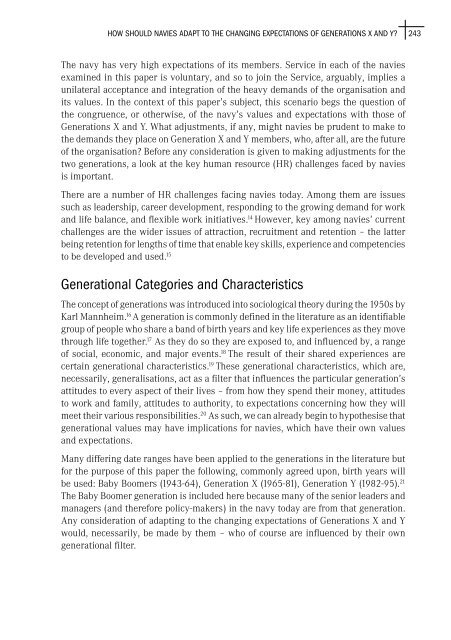Australian Maritime Issues 2007 - Royal Australian Navy
Australian Maritime Issues 2007 - Royal Australian Navy
Australian Maritime Issues 2007 - Royal Australian Navy
Create successful ePaper yourself
Turn your PDF publications into a flip-book with our unique Google optimized e-Paper software.
How Should Navies Adapt to the Changing Expectations of Generations X and Y?<br />
243<br />
The navy has very high expectations of its members. Service in each of the navies<br />
examined in this paper is voluntary, and so to join the Service, arguably, implies a<br />
unilateral acceptance and integration of the heavy demands of the organisation and<br />
its values. In the context of this paper’s subject, this scenario begs the question of<br />
the congruence, or otherwise, of the navy’s values and expectations with those of<br />
Generations X and Y. What adjustments, if any, might navies be prudent to make to<br />
the demands they place on Generation X and Y members, who, after all, are the future<br />
of the organisation? Before any consideration is given to making adjustments for the<br />
two generations, a look at the key human resource (HR) challenges faced by navies<br />
is important.<br />
There are a number of HR challenges facing navies today. Among them are issues<br />
such as leadership, career development, responding to the growing demand for work<br />
and life balance, and flexible work initiatives. 14 However, key among navies’ current<br />
challenges are the wider issues of attraction, recruitment and retention – the latter<br />
being retention for lengths of time that enable key skills, experience and competencies<br />
to be developed and used. 15<br />
Generational Categories and Characteristics<br />
The concept of generations was introduced into sociological theory during the 1950s by<br />
Karl Mannheim. 16 A generation is commonly defined in the literature as an identifiable<br />
group of people who share a band of birth years and key life experiences as they move<br />
through life together. 17 As they do so they are exposed to, and influenced by, a range<br />
of social, economic, and major events. 18 The result of their shared experiences are<br />
certain generational characteristics. 19 These generational characteristics, which are,<br />
necessarily, generalisations, act as a filter that influences the particular generation’s<br />
attitudes to every aspect of their lives – from how they spend their money, attitudes<br />
to work and family, attitudes to authority, to expectations concerning how they will<br />
meet their various responsibilities. 20 As such, we can already begin to hypothesise that<br />
generational values may have implications for navies, which have their own values<br />
and expectations.<br />
Many differing date ranges have been applied to the generations in the literature but<br />
for the purpose of this paper the following, commonly agreed upon, birth years will<br />
be used: Baby Boomers (1943-64), Generation X (1965-81), Generation Y (1982-95). 21<br />
The Baby Boomer generation is included here because many of the senior leaders and<br />
managers (and therefore policy-makers) in the navy today are from that generation.<br />
Any consideration of adapting to the changing expectations of Generations X and Y<br />
would, necessarily, be made by them – who of course are influenced by their own<br />
generational filter.
















